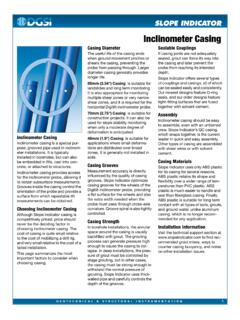Transcription of Cement-Bentonite Grout Backfill for Borehole Instruments
1 Cement-Bentonite Grout Backfill forBorehole InstrumentsP. Erik MikkelsenCurrent Use of BentoniteMaterials and TechnologyAlthough this article advocates the useof Cement-Bentonite Grout it is appropri-ate to review current bentonite backfilland sealing products to illustrate whytheir use should be limited. To the unini-tiated, there is a confusing array of vari-ous pellets, chips, granulated and pow-der-forms of sodium bentonitecommercially available in North Amer-ica and elsewhere. Calcium type mont-morillonite and opalite are also proper use of these products is amature and complex technology em-ployed by the environmental, wa-ter-well and petroleum industries.
2 Basicresearch has been done and their prop-erties are known. For example, BaroidIndustrial Products (1994), a manufac-turer of about two-dozen drilling-prod-ucts gives a five-day workshop in Hous-ton, Texas including a hands-onlaboratory day. Here, the user learnsabout the difference between drillingmuds and bentonite used for sealing(single-component grouts) and how toplace the materials. However, drillersand geo-professionals who installpiezometers and other Borehole instru-ments for the geotechnical industrygenerally do not have this backgroundand often have limited understanding ofbentonite products outside of powderused to make mud and dropping chipsdown the hole.
3 Going high-tech re-quires more knowledge, better equip-ment, and a higher level of quality con-trol, which appears to be unrealistic forborehole bentonite SealsInstallation of bentonite balls, pellets orchips as seals above a sand pocket havedominated piezometer installation pro-cedures over the last 50 years. It is clas-sic procedure for open standpipepiezometers. Installation is usually verytime consuming, particularly on deeperboreholes or when caving occurs. Whenyou manage to get such seals installedwithout bridging the hole, there is usu-ally no question about their permeabil-ity being adequately low.
4 These sealshave a very low permeability, oftenlower than many in-situ clays. Estab-lishment of proper procedures forplacement of such materials has beenimportant not only because sealing isimportant, but also because the installa-tion conditions are often difficult andthe procedures cumbersome. Many in-stallations end up less than the last decade, experience hasshown that bentonite chips (as opposedto balls and pellets) are the easiest toplace. These chips look like crushedgravel and hydrate very slowly.
5 How-ever, the fine clay-dust unavoidablymixed in with the chips can make condi-tions increasingly sticky as filling pro-ceeds, leading to bridging and blockagehigher in the Borehole . For relativelysimple installations where the sealheights and volumes are not too exten-sive, this material usually does notbridge and is often the seal of choice forenvironmental observation wells andopen standpipe , chips and polymer-sus-pended granules can also be tremied tothe desired location in the boring. Thepotential for clogging is always a hazard,but at least a clogged tremie-pipe can bewithdrawn and discarded.
6 If clogging orbridging occurs while dropping the ma-GEOTECHNICAL INSTRUMENTATION NEWSG eotechnical News, December 2002 The Backfill for a Borehole instrument is often an item that receives adisproportionate lack of attention. The behavior of the Backfill , thematerial that is in the most intimate contact with both the formationand the instrument, is critical for obtaining correct measurements. Inmany situations, instrument observations may just reflect unstablebackfill, lack of Backfill or Backfill that is too stiff or too soft. Sand,gravel and various bentonite products have proven to be both toodifficult to place and often entirely inappropriate.
7 Experience hasshown the author that Cement-Bentonite Grout is the most universallyapplicable material for successfully backfilling a Borehole bentonite grouts have been used in related indus-tries a long time, and have been adopted for Borehole instrumentationwith mixed success. Their uses are more involved and, as explainedbelow, should be avoided. The use of fly ash as a substitute for cementpromises to be a good way for reducing Grout stiffness when directly into the Borehole , there isno recourse except to start GroutsThese products are the least desirablefor sealing or backfilling.
8 They aremade from water and powdered benton-ite mixed into slurry-like drilling mud,but to a higher density with the aid ofadditives and specialized Grout mixingunits. The higher the bentonite sol-ids-content is, the lower the permeabil-ity is. The water-content of such slurryis extremely high and it never really setsup to anything more than thick paste,not a solid like the chip-seals. A numberof bentonite sealing grouts are avail-able, but none appear to set up to a solidform. They are sensitive to over-mixing(leading to a flash set) and can be diffi-cult to pump down the small diametergrout pipes (3/4 inch) often used forpiezometers and other geotechnicalborehole Instruments where space is at apremium.
9 Their working time tends tobe too short, and mix dilution to circum-vent mixing and pumping problems willlead to a permanently soupy GroutsBasicsA bentonite Grout Backfill consisting ofjust bentonite and water may not be vol-umetrically stable and introduces un-certainty about locally introduced porewater pressures caused by the hydrationprocess. Introducing cement , even asmall amount, reduces the expansiveproperties of the bentonite componentonce the Cement-Bentonite Grout takesan initial set. The strength of the setgrout can be designed to be similar tothe surrounding ground by controllingthe cement content and adjusting themix proportions.
10 Controlling the com-pressibility (modulus) and the perme-ability is not so easy. Weakercementitious grouts tend to remainmuch stiffer than normally consolidatedclays of similar strengths. The bentonitesolids content has the greatest influenceon the permeability of cement -benton-ite Grout , not the cement grouts are easierto use than bentonite grouts, provide along working time before set and aremore forgiving should the user deviatefrom the design recipe or mixing equip-ment and method. It is easier to adjustthe Grout mix for variations in tempera-ture, pH and cleanliness of the bentonite grouts must be mixedand deployed by strictly following mea-sured quantities and procedures that arenot common practice among drillers do-ing test and DeformationThe general rule for grouting any kindof instrument in a Borehole is to mimicthe strength and deformation character-istics of the surrounding soil rather thanthe permeability.






